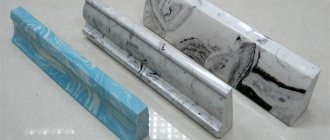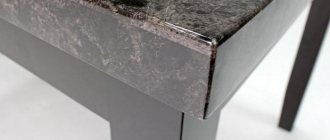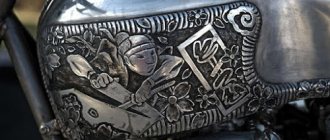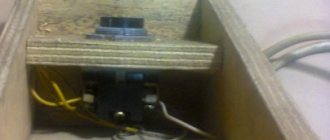Products that imitate natural stones have high strength, resistance to chemicals, environmental friendliness, shock and heat resistance, as well as other advantages. Artificial marble is made from concrete, gypsum and polyester resin and is used not only for cladding houses, but also in the manufacture of countertops, stairs, window sills, fountains and much more.
To make artificial marble with your own hands, you need to decide on the technology for its production.
Description and types of material
Artificial marble is a decorative and building material that quite accurately imitates natural stone. It is widely used in construction, renovation and industrial applications.
For its production, both mineral components and synthetic resins and other additives are used. Due to the special method of introducing dyes, the surface of the finished product has a characteristic pattern with marble stains and specks.
Artificial marble has many positive characteristics:
- high mechanical strength;
- durability, long period of operation;
- low thermal and electrical conductivity;
- fire safety;
- environmental friendliness, harmlessness;
- resistance to acids, alkalis, fats, moisture;
- aesthetic appearance;
- hardness, ease of processing.
Depending on the production method, artificial marble can be cast, cast, ground or liquid.
Liteva
This composite material is the most popular, since the injection molding method is applicable even at home. The basis of artificial marble is a mineral filler (quartz sand or stone chips) and polyester resin. In industry, plasticizers and other targeted additives are also added to the composition.
Oselkovy
The material is a marble-painted gypsum mass, which is diluted with an adhesive solution. Substances that slow down the setting of gypsum must be added to the composition. Due to grinding and polishing, products made from ashlar marble have a beautiful shine. They turn out durable and lightweight.
Oselok marble slabs
Important! Products made from oselkov marble do not tolerate high humidity.
Ground (microcalcite)
Crushed (ground) marble is a white, grayish powdery material obtained by grinding marble chips. It is used for the production of paints and varnishes, linoleum, and various types of plastic. Finished products are durable and resistant to UV radiation, but their moisture resistance is quite low.
Liquid
The material is produced by combining marble chips and acrylic polymers. It is lightweight, flexible, completely non-toxic and environmentally friendly. Due to their small thickness, sheets of liquid artificial marble can be cut with scissors and used instead of wallpaper. The surface will be smooth, seamless and durable.
Cast marble
The base for this material is polyester resin and any mineral filler (marble chips, crushed white quartz and other fine components). The latter make it possible to produce slabs stylized as granite, malachite, jasper and onyx.
To make cast artificial marble at home, you will need to prepare a solution:
- Polymer concrete. To do this, you need to mix 20-25% polyester resin with 75-80% crushed neutral mineral.
- Butacryl. In this case, instead of resin, AST-T and butacryl are used in equal proportions, after which 50% quartz sand or crushed crushed stone is added to the mixture.
You will also need to prepare river sand, pigment, gelcoat and plasticizer. The technology for manufacturing artificial marble from resin includes the following steps:
- Lubricate the matrix for the future artificial stone with gelcoat and let the form dry.
- Prepare the solution using one of the methods described above.
- Pour the liquid solution into the matrix and remove any excess.
- Cover the mold with film and wait 10 hours.
- Remove the finished artificial stone from the mold and leave it in the open air for a while.
The hardened stone can be further polished or left without machining.
Despite the simplicity of producing such artificial raw materials, the casting method of producing marble is highly expensive, so it makes sense to consider other methods of creating stones.
Production of cast artificial marble
Before starting work, you need to immediately prepare all materials and consumables, as well as buy or rent tools and equipment for marble production.
Equipment
First of all, you need matrices - forms for pouring the marble mixture. Polyurethane molds have proven themselves best - they are very durable and do not deform, although they are not cheap.
Table top mold
You will also need:
- components for mixing the composition;
- construction mixer;
- Sander;
- capacity;
- gelcoat sprayer or mold brushes.
Composition of raw materials
The main components are polyester resin (gelcoat) and marble chips (flour) in a 4:1 ratio. Cement, gypsum, lime, and quartz sand are also used to improve strength and improve performance characteristics.
Important! If desired, cement can completely replace the polyester resin in the composition, but the reliability of the finished marble will decrease.
In this case, the “recipe” for the solution will be as follows:
- sand – 2 parts;
- cement – 1 part;
- small stone chips – 25% of the total volume;
- water – 0.2 parts;
- plasticizer – 1% by weight of cement;
- pigment – 1% by weight of cement.
Do-it-yourself donkey marble manufacturing technology
Making marble at home
If you wish, have free time and the ability to work with hand tools, you can make touchstone marble with your own hands. For this you will need: plaster, wood glue, resin, coloring pigment, and a mold for pouring.
Work should be performed in the following sequence:
- In a prepared container, using a construction mixer, you need to knead plaster using water and wood glue.
- Melted resin is poured into the prepared mass.
- The resulting composition is mixed and a coloring pigment is added to it.
- The newly obtained mass is mixed until inclusions and streaks appear in it.
- The finished mass is poured into the prepared form.
- The resulting excess is removed.
- Drying occurs within 10.0 hours, after which the resulting slab is removed from the mold.
- The surface of the slab is treated with potassium silicate, which will increase the resistance of the manufactured product to moisture.
- The slab is dried and polished using soft felt or special abrasive materials. Polishing is carried out until a mirror surface is formed.
The advantages of Oselkov marble are:
- Good indicators of durability and operation.
- Ability to perform varying degrees of decoration when decorating objects.
- Affordable price.
- Possibility of making it yourself.
- It is a non-flammable material that does not support combustion;
- Inert towards chemicals.
- Has an insignificant specific gravity.
- Has a long service life.
- Does not require additional care during operation.
- It is resistant to natural phenomena (sun rays, ambient temperature, etc.).
Disadvantages of donkey marble:
- The complexity of the work, requiring skills in working with similar materials and professionalism of the worker.
- Strength is lower than that of natural marble.
- When used in difficult conditions (flights of stairs, etc.), products made from this material are subject to abrasion and can be scratched and split.
- With prolonged exposure to moisture, it is susceptible to destruction.
Production technology
The method of producing artificial marble is simple, it is only important to follow the specified recommendations.
Preparation of the solution
Pour the dry ingredients into a clean container, mix them thoroughly with a mixer and add the dye. The latter is mixed in carefully to maintain the uneven color of the finished material.
Then the mass is diluted with water, shaken well or placed on a vibrating table - this will help get rid of air bubbles. Water is introduced in 2 steps: first, 80% of the liquid is added, then the plasticizer is added, and then the remaining water.
Preparation and filling of forms
The molds are placed in a strictly horizontal position, sprayed with gelcoat (polyester resin), and the solution is poured. Shake to get rid of excess air and leave to harden for at least a day under the film.
Advice! To enhance the strength of marble, reinforcement is made - a wire mesh is placed in the thickness of the solution.
Processing of finished slabs
After curing, the molds are turned over, the stone slabs are taken out and sanding begins. Such products can only be cut with equipment equipped with diamond blades.
ARE THERE PROSPECTS FOR TOUCH MARBLE TECHNOLOGY?
Good afternoon ! Please express your opinion on the prospects of technology. We are talking about an ancient Italian technology - ashlar marble. Few people know about her. This technology is one of the areas of the Scagliola technique, brought to Russia during the time of Peter I and actively used in the decoration of palaces and estates, which is a type of decorative plaster that imitates finishing with natural stone.
Greek Hall of the Imperial Palace in Pavlovsk.
This technique was actively used in their creations by Giacomo Quarenghi, Bazhenov, Cameron, Montferand, Rastrelli, Stasov, Rossi. The Hermitage, the Imperial Palace in Pavlovsk, the Marble Hall of the Mikhailovsky Palace, the Maltese Chapel, the Yusupov Palace - these are the monuments of St. Petersburg in which the technology of touchstone marble was actively used.
House Church of John of Jerusalem in Pavlovsk.
In Moscow, these are the Historical Museum, the Bolshoi Theater, the A. S. Pushkin Museum, the Rosstat building on Myasnitskaya designed by Le Corbusier, and the buildings of Moscow State University. Almost every city estate of the 17th and 18th centuries has elements of cladding with oselkov marble in its interior decoration. Perhaps the most famous object abroad is Buckingham Palace with its “lapis lazuli” columns.
Shekhtel staircase of A. A. Levenson’s speed printing house -
it is from our latest works.
The essence of the technology is to apply a solution of a mixture of animal glues, gypsum and dry colored pigments to the surface in order to obtain a pattern of veins of natural stone, only, unlike marble, the color range can be very diverse. After drying, the cladding is polished by hand with moisture, obtaining a gloss like that of natural stone and acquiring strength comparable to the strength of soft types of natural marble. Often, non-specialists cannot distinguish natural marble from stone marble. The technology is extremely labor-intensive, labor costs per 1 sq.m. amount to at least 100 people/hours, and since these are also highly artistic works, their cost is quite high (from 10 thousand rubles per 1 sq.m.). In addition, the work requires strict adherence to the temperature and humidity conditions at the site.
Branch of the State Academic Theater of the Russian Federation.
Currently, the technology can be called dying - specialists can be counted on one hand. Our brigade is one of the few remaining. Until recently, we were in demand on sites being restored, but currently the realities of construction projects with ever-tight deadlines and financial shortages are forcing customers to refuse full restoration and recreation of stone marble, and resolve the issue by simulating restoration by guest workers, at best, sealing it with putty cracks and covering the surfaces with varnish, in the worst case, knocking down the sandstone marble, replacing it with plaster and painting. Specialists have to reorient themselves to related specialties - performing plastering and stucco work.
Columns. Temple of the Icon of the Vladimir Mother of God.
In connection with the current situation, the following question arises: is it worth thinking about promoting the technology towards private customers who want to receive elite palace decoration in interiors, or does the technology have no prospects, due to the high cost, long lead times and the need to strictly adhere to production conditions?
Use and care instructions
Artificial marble is often used for decorating rooms and wall cladding. It makes beautiful tabletops, window sills, stairs, sculptures, and decorative fountains. The material is suitable for finishing house facades, emphasizing window and door openings, and creating paving slabs.
Artificial marble should be cleaned with a soft cloth, as hard brushes can leave scratches on it. It is washed using liquid SMS and does not use drying oil-based products for polishing. Otherwise, the material is considered quite unpretentious and, with the right approach, will last for many years.











